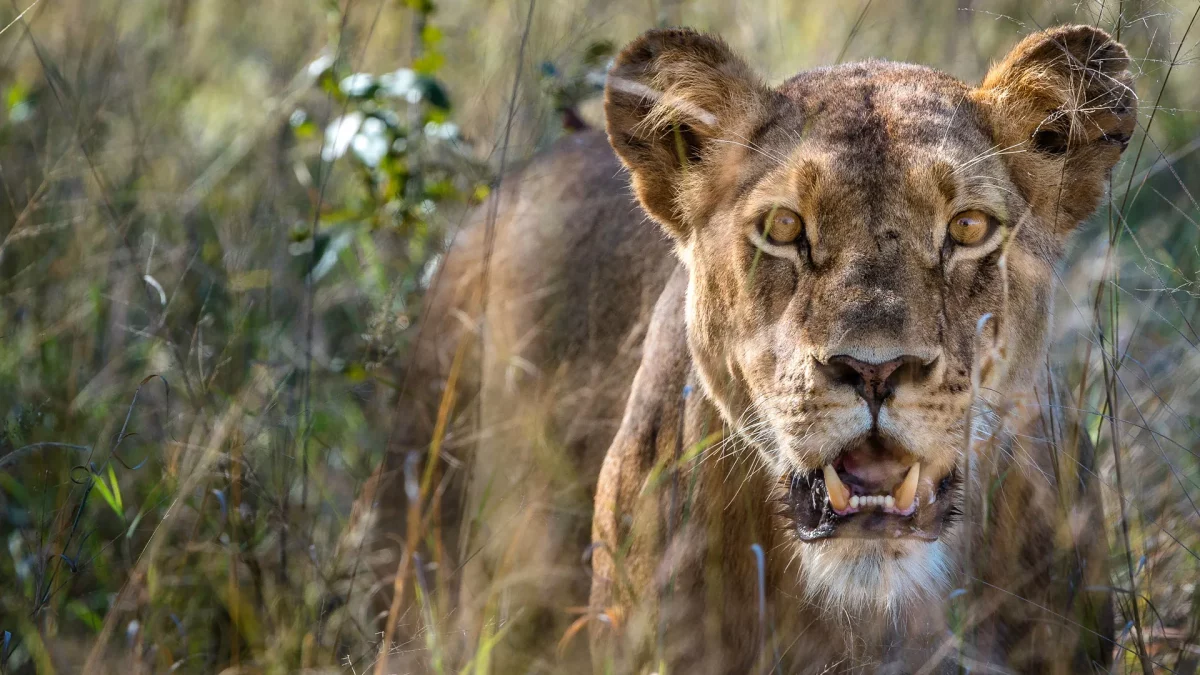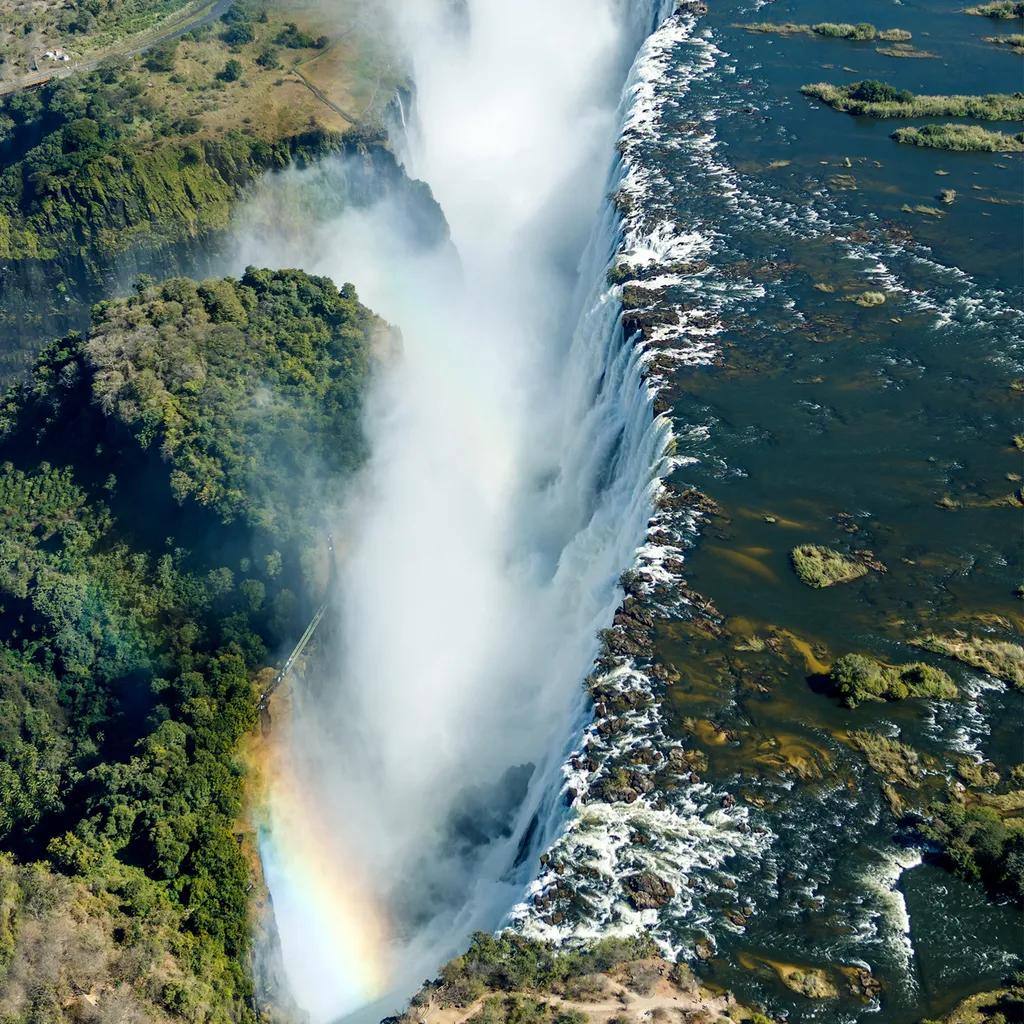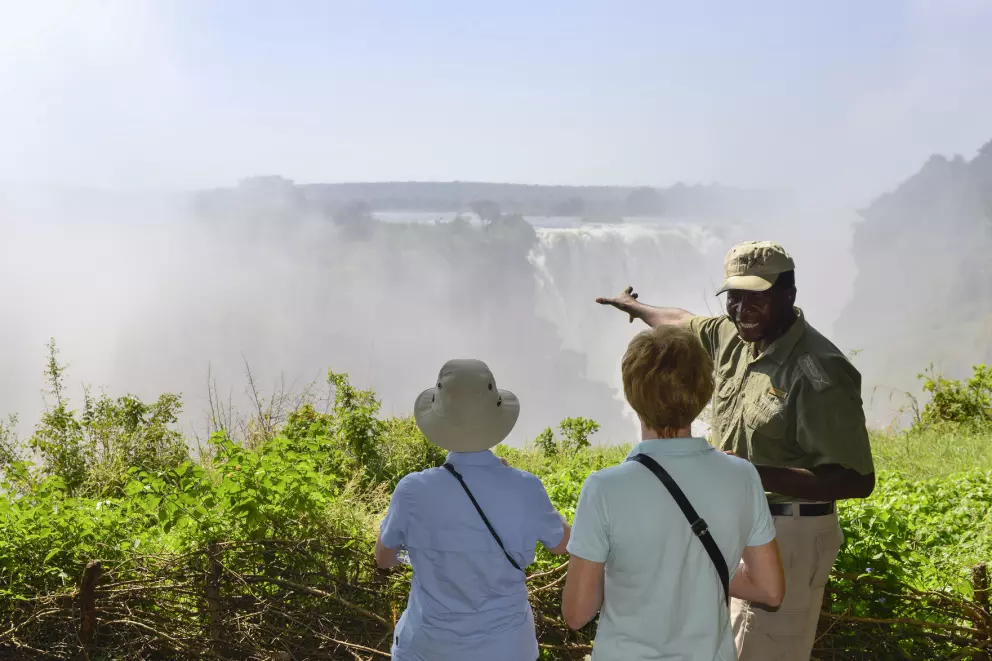Blessed with the planet’s most colossal waterfall, abundant sunshine and striking scenery, the natural beauty of Zimbabwe is world-famous.
Home to determined locals full of creativity enthusiasm and hope, expect a warm welcome and generous hospitality on your Zimbabwe safaris. Visit a local market where traditional soapstone carving, weaving, painting and beadwork are important features of Shona culture and folklore. Discover deep caves that are filled with silent pools explored by US Navy divers and tour the world’s biggest artificial lake by volume – Lake Kariba.
Zimbabwe boasts one of the Seven Wonders of the World (the Victoria Falls), but there is so much more to experience: Mana Pool National Park’s great canoeing and walking safaris, Matobo’s majestic leopards, Hwange’s plethora of wildlife, the dramatic remoteness of Gonarezhou, and the gorgeous sunsets over Lake Kariba. Overlook Zimbabwe safaris and you’ll miss an important piece of Africa’s ancient heart.
Why Visit Zimbabwe?
It is the Zimbabwe’s myriad wildlife, top-class safari guides and diverse safari parks – along with Victoria Falls – the reason why thousands of safari lovers visit the country every year. Zimbabwe takes conversation seriously and has a network of sizable wildlife reserves.
The safari guides in Zimbabwe are among the best in the world thanks to their exceptionally thorough training. It takes at least 5 years to complete the course, which involves everything from learning all the Latin names of plant, bird, insect and animal species to basic first aid, advanced driving skills and weapons training.
Because of how difficult it is, only about 5% of entering students make it to the final written exams. The exceptional expertise and enthusiasm for the bush, along with the friendly and fun-loving people of Zimbabwe put Zimbabwean guides at the top of their field.
Best Zimbabwe Safaris And Victoria Falls Tours
What are the best Places to visit in Zimbabwe?
1. Victoria Falls
The Victoria Falls – a World Heritage Site and one of the Seven Natural Wonders of the world – is possibly the major tourist attraction in Zimbabwe. Known by locals as Mosi-oa-Tunya, or “the smoke that thunders,” the falls were first seen by Western eyes in 1855 when British explorer Dr. David Livingstone came upon it and named it after his queen. Reflecting on the experience of seeing Victoria Falls for the first time, he wrote, “Scenes so lovely must be gazed upon by angels in their flight.”
With a combined height of 108m and width of 1 708m, it is the largest waterfall on Earth. Venezuela’s Angel Falls is higher but not wider. It is 1.5 times wider than and doubles the height of Niagara Falls.
The falls straddles Zimbabwe to the west and Zambia to the east. You can access it from either country, via the town of Victoria Falls in Zimbabwe or Livingstone in Zambia. Fed by the Zambezi River, Victoria Falls offer all sorts of adventure activities like:
- Bungee jumping
- White-water rafting
- Swimming in Devil’s Pool on the precipice
- Visits to Livingstone Island
- Bridge swinging
- Sunset cruises
2. Hwange National Park
The biggest and best-known wildlife park in Zimbabwe is Hwange (pronounced ‘wang-gee’). Almost ten times the size of London, Hwange National Park spans some 14 600km2 and provides a haven for 107 mammal species and more than 400 species of birds. Aptly known as ‘the land of giants’, the park is home to around 60,000 African bush elephants, making it the second largest elephant population in the world after Botswana’s Chobe National Park. Hwange is usually combined with Victoria Falls as they are closest to each other. This is possibly the best place to see African Big 5 animals in Zimbabwe, although rhinos are only seen on rare occasions.
3. Matobo National Park
Idyllically situated in the spectacular Matobo Hills in the south west of Zimbabwe, Matobo National Park is allegedly the location of Ophir, the biblical land from where King Solomon got ivory, gold and exotic birds. This pristine natural wilderness features a range of massive red-tinged, granite boulders interspersed with gorgeous wooded valleys making it a dream destination for hikers and nature lovers.
Other places of interest include the burial site of Ndebele king Mzilikazi, who chose the park’s name (Matobo means ‘bald heads’!), and the grave of Cecil John Rhodes, at the summit of the hill known as Malindidzimu (‘hill of benevolent spirits’). The park is compact (424 km2) but it contains an impressive range of African wildlife including the highly endangered black and white rhinos.
Its granite outcrops are the ideal hunting grounds for Zimbabwe’s supposedly highest concentration of leopards, as well as raptors like the Bateleur eagles. One of its most famous sites is the ‘balancing rocks’, where strangely large boulders are stacked up in a row, without mortar or supports.
4. Mana Pools National Park
Located in the north of Zimbabwe near Zambezi River, Mana Pools National Park is one of the prettiest wildlife reserves in the whole world. The word ‘mana’ means four in the local Shona language, referring to the four large pools created by Zambezi River’s changing course in ancient times. These pools support a plethora of wildlife and activities like canoeing – a terrific way to see elephants, hippos, crocodiles and fantastic waterbirds like jacanas, herons, and terns. Mana is also one of the best places in Southern Africa to see endangered African painted wolves (wild dogs).
5. Gonarezhou National Park
Situated in southern Zimbabwe, Gonarezhou (‘gone-a-rez-who’) is off the beaten track. Its most well-known landmark is the striking red sandstone Chilojo Cliffs, which offer a beautiful backdrop to late afternoon sundowners on game drives and glow red in the setting sun. Another highlight of Gonarezhou National Park is Chivilia Waterfalls, which flow fastest during the summer rainy season.
6. Lake Kariba
Lake Kariba was dammed to supply hydroelectric power to Zimbabwe and Zambia. The lake is affectionately known as ‘the Riviera of Zimbabwe’ due to its many upscale houseboats that dot its shores. It is a perfect place for bird watching and Spurwing Island – named after the African spur-winged goose – is testimony to this. The geese are famed for diving for fish and are very social, often living in communities of up to 50 birds. Lake Kariba is an underrated destination and a wonderful place for a ‘beach holiday’ amid a safari country.
7. Matusadona National Park
Matusadona is located on the southern shore of Lake Kariba. The park takes its name from the Matuzviadonha Hills. This is a remote place accessible only by light aircraft, 4×4 convoy or boat and is considered one of Zimbabwe’s hidden gems. It is a haven for critically endangered black rhinos, African elephants, Cape buffalos and the famous Matusadona lion prides.
8. Great Zimbabwe Ruins
The local Shona people built the Zimbabwe Ruins from the 11th century by carefully dry packing thousands of stones into intricate patterns, towers and staircases.
Between the 13th and 15th centuries, around 20,000 people resided here on a site that was 1 722 hectares big. It was the trading centre for the Mutapa Kingdom and is now a UNESCO World Heritage Site. So significant are the ruins that Zimbabwe is named after them: ‘dzimba’ means ‘houses’ and ‘mabwe’ means ‘stones’ making up ‘Zimbabwe’ or ‘Great Houses of Stone’.
Zimbabwe is a large country and first-timers generally visit Victoria Falls, Hwange and Mana Pools as these have the best infrastructure and are easiest to reach. Visiting other tourists sites in this far-flung land is recommended for experienced travellers.
FAQs About Zimbabwe Safaris
1. When To Go For A Safari In Zimbabwe?
The best time of the year to go for a safari in Zimbabwe is from July to September. This is the middle and end of the Dry season, which is most favorable for watching wildlife. As the water dries out in the bush, animals congregate around sources, which make them easier to see. The lush vegetation shrinks as the Dry season progresses and this also makes wildlife viewing easier.
Note though that the Dry season is the southern hemisphere winter, and it will be cold in the mornings and at night. Mainly so on early morning and later afternoon wildlife game drives.
The best time to see Victoria Falls is from June to August, when there is lots of water, but not so much that the spray obscures the view.
2. Is it safe to go on safari in Zimbabwe?
It is no secret that the people of Zimbabwe have survived intense political unrest, beginning with the country’s colonization in the 1800s. By the 1990s, then President Robert Mugabe was desperate to hold onto power and by the early 2000s had launched an ambitious but unfortunate land redistribution programme with the goal of empowering ordinary people of Zimbabwe.
To earn a living, several Zimbabweans migrated to the neighbouring countries and those who lived in rural areas sometimes had to resort to poaching to survive. This in turn, together with widespread and prolonged drought, had a negative effect on wildlife areas.
What had once known as the bread basket of Africa due to its exceptionally fertile soil that supported large expanses of maize and which was regarded as a premier Africa safari destination became disadvantaged by food, fuel and cash shortages.
Under those conditions, safety was a serious consideration. We’re happy and confident to declare that Zimbabwe has successfully come through this difficult time.
Even though there is still a great deal of poverty, the political climate has much improved after Robert Mugabe’s resignation in late 2017. You’re also quite unlikely to run into any problems when visiting the national parks and other Zimbabwe safaris destinations.
In a nutshell: yes, it is safe to go on a safari in Zimbabwe. Many people from all over the world marvel at its wildlife and natural beauty every year, and there’s no reason why you can’t be among them.
3. How much does a safari in Zimbabwe cost?
A budget Zimbabwe safari costs from around $150, a mid-range Zimbabwe safari from $300, while a top-end Zimbabwe safari can easily cost over $1,000, all per person per day. Most people who visit Zimbabwe for a safari tend to be on top-end safaris, but it is possible to visit on a more reasonable budget. Below is a costing table to gives you an instant overview of how much the average safari in Zimbabwe will cost, depending on your travel style. You can use this table to quickly match your daily budget to the kind of Zimbabwe safari you can afford.
| Comfort Level | Private (per day) | Group (per day) |
|---|---|---|
| Budget Camping | $225 | $200 |
| Budget Accommodation | $250 | $225 |
| Mid Range Accommodation | $375 | $275 |
| Luxury Accommodation | $550 | $525 |
| Luxury Plus Accommodation | $1,075 | n/a |



